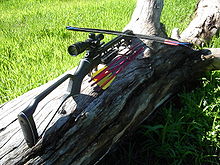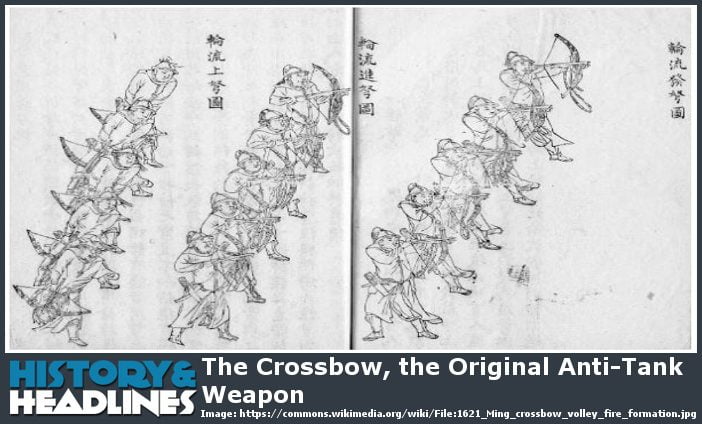A Brief History
On January 23, 971, troops of the Chinese Song Dynasty managed to defeat the War Elephant Corps of the Southern Han Kingdom by the use of deadly crossbows. In those days, elephants were the equivalent of today’s tanks and were a fearsome and seemingly unstoppable force on the battlefield. There was nothing else like warrior pachyderms until tanks were introduced in World War I.
Digging Deeper
The crossbow, consisting of a horizontal bow crossed by a straight stock held by the bowman, had been invented in China perhaps as early as the 4th century B.C. or even earlier. The string would be held back by a lock-and-trigger mechanism that when released would launch the bolt (arrow). These could range in size from one-hand “pistol” type weapons up to giant “ballista” siege weapons that could launch giant bolts sometimes several feet long and up to nearly 200 pounds against fortifications! These were much more precise than other types of ancient artillery such as the catapult or trebuchet. Ballistae had a range of 300 to 1,200 yards and were even used on ships against other ships.
The advantage of the crossbow is that once the bowstring is set, the bowman does not have to struggle to hold the string back but can wait until he has properly aimed to release the bolt. By using a crank or lever type of cocking mechanism, the bowman can load the bow with tremendous stored energy, thereby launching the projectile at such a high rate of velocity that the steel-tipped bolt can pierce armor.
The other huge advantage of the crossbow is, unlike the longbow which takes several years of training and practice to develop the skill and strength needed for warfare, that it is easy for a beginner to master.
The Medieval crossbow was so effective and deadly that there were strong feelings that Christians should not use such weapons against other Christians. Such proscriptions, however, went by the wayside when battlefield practicality came into play.
Crossbows fell out of favor when firearms became common, although today modern militaries (including the U.S.) use crossbows to launch grappling hooks and ropes and many crossbows are still also being manufactured for hunting, often mounted with rifle-type scopes. Crossbows cost about what a cheap rifle costs and are easy to learn to use. The author strongly recommends them to hunters looking to extend their hunting season and who want to try something different. The author has taken 2 white-tailed deer with a Horton crossbow and can attest to their effectiveness and accuracy. Toy crossbows are even available for early exposure for future hunters.

Question for students (and subscribers): Have you ever used a crossbow? Please let us know in the comments section below this article.
If you liked this article and would like to receive notification of new articles, please feel welcome to subscribe to History and Headlines by liking us on Facebook and becoming one of our patrons!
Your readership is much appreciated!
Historical Evidence
For more information, please see…
Gallwey, Ralph Payne. Crossbow Mediaeval and Modern Military and Sporting. Holland Press Ltd, 1814.
O’Bryan, John and Barry Orkin. A History of Weapons: Crossbows, Caltrops, Catapults & Lots of Other Things that Can Seriously Mess You Up. Chronicle Books, 2013.
The featured image in this article, an image by Yprpyqp illustrating what the author refers to as the ancient technique of “ten thousand crossbows shooting in concert” (萬弩齊發), is licensed under the Creative Commons Attribution-Share Alike 4.0 International license. The crossbowmen on the right are at the fore and are shooting. The ones in the middle are ready to shoot. The ones to the left are in the back reloading. “In this way,” writes the author, “they revolve and take turns firing a constant stream, and the crossbows sound without cease.”
You can also watch a video version of this article on YouTube:



<span class="dsq-postid" data-dsqidentifier="8563 https://www.historyandheadlines.com/?p=8563">27 Comments
I’m confident John J Rambo used a compound bow, not a crossbow. Of course he also used an electrified boxsprings, so maybe I’m being picky, but in any case, there was no crossbow. Maybe in later movies
Dear Marvin, Thank you for bringing this to our attention. We have deleted the sentence. The author speculates he was confused thinking John Rambo should have used a crossbow.
When I hear of a crossbow I associate it more with hunting animals rather than killing people. I was involved in archery as a girl scout. I’m sure during that time I was informed of the back ground, somewhat, but not to the extent of this article.
There have been cases in films and shows of there being just this seemingly unstoppable person who just goes around killing with crossbows. It’s interesting to see that they’re truly as devastating as they are portrayed, even a little more so.
Good job China, I’ve never used one, but I have used a regular bow that you pull back and hold and it is really hard to aim and keep steady.
Crossbows are my favorite to shoot and I love bow season so reading and article about their history was very interesting to me!
I really enjoyed this article learning about the history of cross bows and how good they were back then and today for hunting and war.
Crossbows are wonderful
I enjoyed reading this and learning how good the crossbows were back then
As technology behind weaponry became more deadly, it’s no wonder how the large slow moving elephant target would become quickly phased out of warfare.
I find it interesting that people use crossbows in general. I find it would be a lot harder than using a gun, however I do see why hunters use them though, it saves a lot more meat than a gun would. I just find it odd that they used crossbows to kill people… defiantly a new one for me.
I would really love how to use a cross bow! It seems like a wonderful craft.
its so cool how crossbows have still been used since early times.
I believe that reasons crossbows aren’t as popular today is that guns do more damage to the victim even if they do not kill. Because of this in hunting or war guns have become much easier to use.
Cool to see that crossbows still have a useful place today even though weaponry as far advanced beyond it long ago.
Its so cool to see how crossbows were used back then, though iv always thought they where cool considering I watch the walking dead haha!
The crossbow was the most advanced weapon of its era, so far it is still used today. It is cool to see how things may age but still last a long time.
Thats awesome that crossbows were such a big weapon back then! I shoot recurve with my bestfriend for fun and competitions. Its awesome to see how many different kinds of bows there are and their role in history!!
I wonder how much different a cross bow would be to shoot compared to a compact or a recurve.
I own a few crossbows, never thought of them as an anti-tank weapon, but do not question their power. Also enjoy the big buck kill video, I myself have a few kill shot videos on youtube as well, but with my compound bow.
Crossbows have always amazed me. My brother has a toy one and I secretly wish that I had a toy one when I was a kid.
the advancement of weaponry is very fascinating
It’s cool that a weapon that was designed so long ago is still used today.
cross bows are still used today in various activities but the most popular is hunting
i understand how it was needed to feed a village. It is sad though that elephants now are slowly dying off
The cross bow was the original WMD.
It was interesting to learn about the cross bows